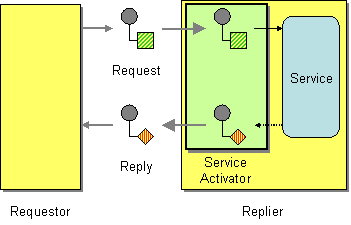Introduction to Service Activator
The purpose of this example is to demonstrate how the WSO2 ESB could be used to implement Service Activator EIP. Service Activator will interface methods and services which are in the back end service layer. Using the Service Activator the back end services can be filtered and displayed to the client.
Example Scenario for the EIP
In the given example it demonstrates how WSO2 ESB can be used to activate only a specific amounts of services which are exposed in the Axis2 server. Using the publishWSDL the service WSDL file was modified to filter out only a specific amount of services. The ability of the ESB to create proxy services will allow the client to invoke the ESB proxy instead of invoking the service in Axis2 server.
Implementing the Example Scenario in WSO2 ESB
Getting Started
The diagram below depicts how to simulate the example scenario using the WSO2 ESB.
Before digging into implementation details, let's take a look at the co-relation of the example scenario and the Service Activator EIP by comparing their core components.
| Figure 1: Service Activator EIP | Figure 2: Service Activator Example Scenario |
|---|---|
| Requestor | Simple Stock Quote Client |
| Service Activator | Proxy Service |
| Replier | Simple Stock Quote Service |
Environment Setup
1. Download and install the WSO2 ESB from http://wso2.com/products/enterprise-service-bus. For a list of prerequisites and step-by-step installation instructions, refer toInstallation Guide in the WSO2 ESB documentation.
2. Start two Sample Axis2 server instances in ports 9001 and 9002. For instructions, refer to section ESB Samples Setup - Starting Sample Back-End Services in the WSO2 ESB Documentation.
ESB Configuration
3. Start the WSO2 ESB and copy the following configuration to the "Source View" in the management console (Main Menu -> Service Bus -> Source View), using which the example scenario can be explored.
<?xml version="1.0" encoding="UTF-8"?>
<definitions xmlns="http://ws.apache.org/ns/synapse">
<proxy name="ServiceActivatorProxy" startOnLoad="true">
<target>
<endpoint>
<address uri="http://localhost:9000/services/SimpleStockQuoteService"/>
</endpoint>
<outSequence>
<send/>
</outSequence>
</target>
<publishWSDL uri="file:repository/samples/resources/proxy/sample_proxy_1.wsdl"/>
</proxy>
<sequence name="fault">
<log level="full">
<property name="MESSAGE" value="Executing default "fault" sequence"/>
<property name="ERROR_CODE" expression="get-property('ERROR_CODE')"/>
<property name="ERROR_MESSAGE" expression="get-property('ERROR_MESSAGE')"/>
</log>
<drop/>
</sequence>
<sequence name="main">
<in/>
<out>
<send/>
</out>
</sequence>
</definitions>
Simulating the Sample Scenario
4. Back end StockQuoteService offers the following services,
- getFullQuote
- getMarketActivity
- getQuote
- getSimpleQuote
- placeOrder
But utilizing the publishWSDL feature only some of the back end features will be published through the Service Activator Proxy. browse http://localhost:8280/services/ to view the services offered through the ServiceActivatorProxy the user will be able to notice that apart from services getMarketActivity and getSimpleQuote all the other services are available and active.
How the Implementation Works
Let's investigate the elements of the ESB configuration in detail. The line numbers below are mapped with the ESB configuration illustrated in step 3 above.
- Proxy [line 3 in ESB config] - the proxy service defined creates a virtual service between the real back end service and a requestor.
- publishWSDL [line 12 in ESB config] - by default a proxy service defines a one-to-one mapping of the back end service interface and provides this in form of a WSDL file that requestors can use to connect to the proxy service. By using the publishWSDL mediator, the proxy service can publish a custom interface and in this case the publishWSDL mediator is used to provide access only to a subset of all the service methods available by the back end service.
